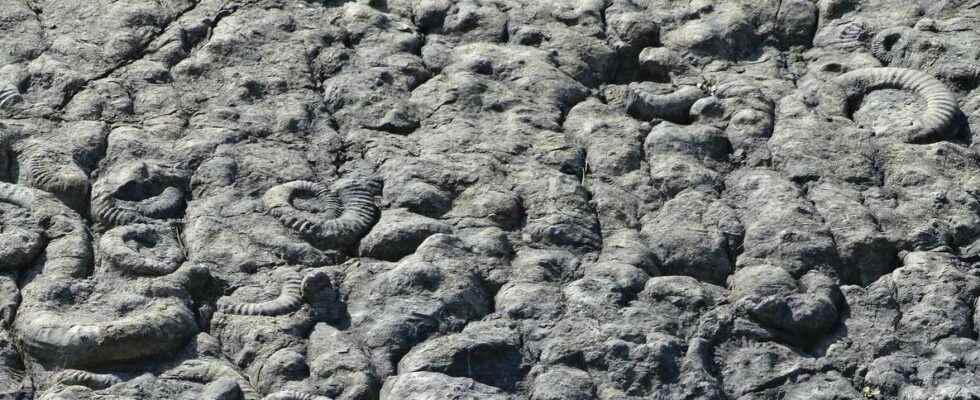You will also be interested
[EN VIDÉO] Interview: where to find dinosaur fossils? Disappeared 65 million years ago, the dinosaurs nevertheless left some traces in fossil form. But what are the most favorable geological conditions for their conservation and where can they be found? Futura-Sciences asked the question to Éric Buffetaut, paleontologist, during this interview.
All lovers of walks attentive to their environment have, one day or another, found even a fragment of fossil: ammonite, rostrum belemnite, shells of bivalves… If exceptional discoveries require more advanced means of prospecting (but also luck), France is very rich in fossils common. Studying geological maps and by spending a little time there, it is not uncommon to make lovely discoveries that would enhance a small collection. It is also a very fun activity for children, which familiarizes them with the geological history of the Earth.
How are fossils formed?
It should be borne in mind that fossils are nothing but the remains of animals, but also of plants, having lived millions of years ago and which have been preserved in a natural way. Be careful though, any organism that dies is not automatically transformed into a fossil. The process of fossilization requires specific conditions.
The essential stage is the rapid burial of the body of the dead animal, under sediment or ash produced by an eruption. Ideally, this step should be done under anaerobic conditions (without oxygen) to limit the action of bacteria. The speed of the burial will depend on the preservation of the soft parts, which are more difficult to preserve than the shells, for example.
Indeed, without burial, the fabrics will quickly be degraded by the microorganisms. This explains why we mainly find fossilized remains of shells or skeletons and that the discovery of remains ofsoft-bodied organisms is much rarer. Under these conditions, it appears that the environment most favorable to fossilization are the circles lake and sailor who are subjected to a process of sedimentation continual.
During burial, tissue degradation will occur, but more slowly, which promotes chemical exchanges between the corpse and the sediments covering it, which will allow the process of fossilization. This process is marked by a transfer mineral : the calcium of biological origin present in bones or shells is thus gradually replaced by another species mineral: calcite, aragonite, pyrite, silicacarbonates or clays. It is therefore essential that these minerals are present in the sedimentary deposits that will cover the dead organism. Finally, the temperature conditions of the burial medium must remain relatively stable throughout the fossilization process.
Fossilization is therefore far from automatic and it is considered that less than 0.1% of organisms become fossils.
Where to find fossils in France?
If burial is a prerequisite for fossilization, tectonic uplift and erosion are equally so with regard to prospecting. Knowing that tons of fossils sleep at the bottom of the oceans is good, being able to find them is better! For this, tectonics will have to do its work and exhume these fossiliferous deposits or erosion will gradually abrade the upper layers, accumulated over several million years.
At the end, the result and there, under our eyes and under our feet. Fossiliferous deposits can be found almost everywhere in France, provided that the age of the land, its composition and its geological history are properly targeted.
The Jura mountains, the whole of southern France, the Massif Central, the Alps and the Pyrenees, but also Brittany and Normandy are regions known for their prospecting potential. Among the most emblematic French sites is La Voulte-sur-Rhône in the Ardèche, famous for its fossils of cephalopods and of shellfish. In particular, there are numerous belemnite rostra, echinodermsfish fossils… The cliffs near Lions-sur-Mer in Normandy are also known for their quantities of fish fossils.sea urchins, rhynchonellae and bivalves. The molasses lands in the department of Tarn but also the Gard are popular sites for fossil researchers.
Beaches, quarries and spoil heaps to maximize your chances
Once the area is defined, it is necessary to target a specific site where the chances of finding fossils will be greater. This is the case of beaches, especially those overhung by cliffs. The continued erosion of waves will indeed allow the discovery of fossils. All you have to do is lower your eyes. The downside: wave action tends to damage fossils. Looking at the wall from the cliff, you may be able to find larger and still intact specimens. Beware, however, of landslides !
Quarries, especially those in operation, are ideal places for prospecting. However, access to them can be complicated, or even forbidden because it is dangerous! It is necessary to obtain information beforehand and to request authorization from the operator. But the excavation of cliffs or rubble can lead to great finds. In general, the piles of rubble resulting from major road works are excellent spots.
How to prepare for your release?
To be sure not to return empty-handed, it is possible to prepare for your trip using a few tools: the sites Geoportal and Infoterre will give you valuable information about the geology of a place. No need to visit a site characterized by the presence of granite or gneiss, you won’t find anything there. Areas need to be targeted limestone, then particular ages. For example, limestone ordovicians are rich in trilobites, bivalves and crinoids. The rocks carboniferous are known for their plant fossils,insects and trilobites. The rocks of trias are rich in ammonites, brachiopodssea urchins, vertebrates…
Namely, on the geological map, certain symbols indicate the presence of known fossil deposits. It’s up to you to dig, while respecting the sites you visit. Some very emblematic places are now classified and protected so that everyone can come and contemplate these traces of the past. This is the case of the geological nature reserve of Haute-Provence which notably contains the famous ammonite slab. On all of these sites, it is strictly forbidden to collect fossils.
Interested in what you just read?
